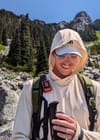Steep Skiing in the North Cascades: Black Peak and Big Kangaroo
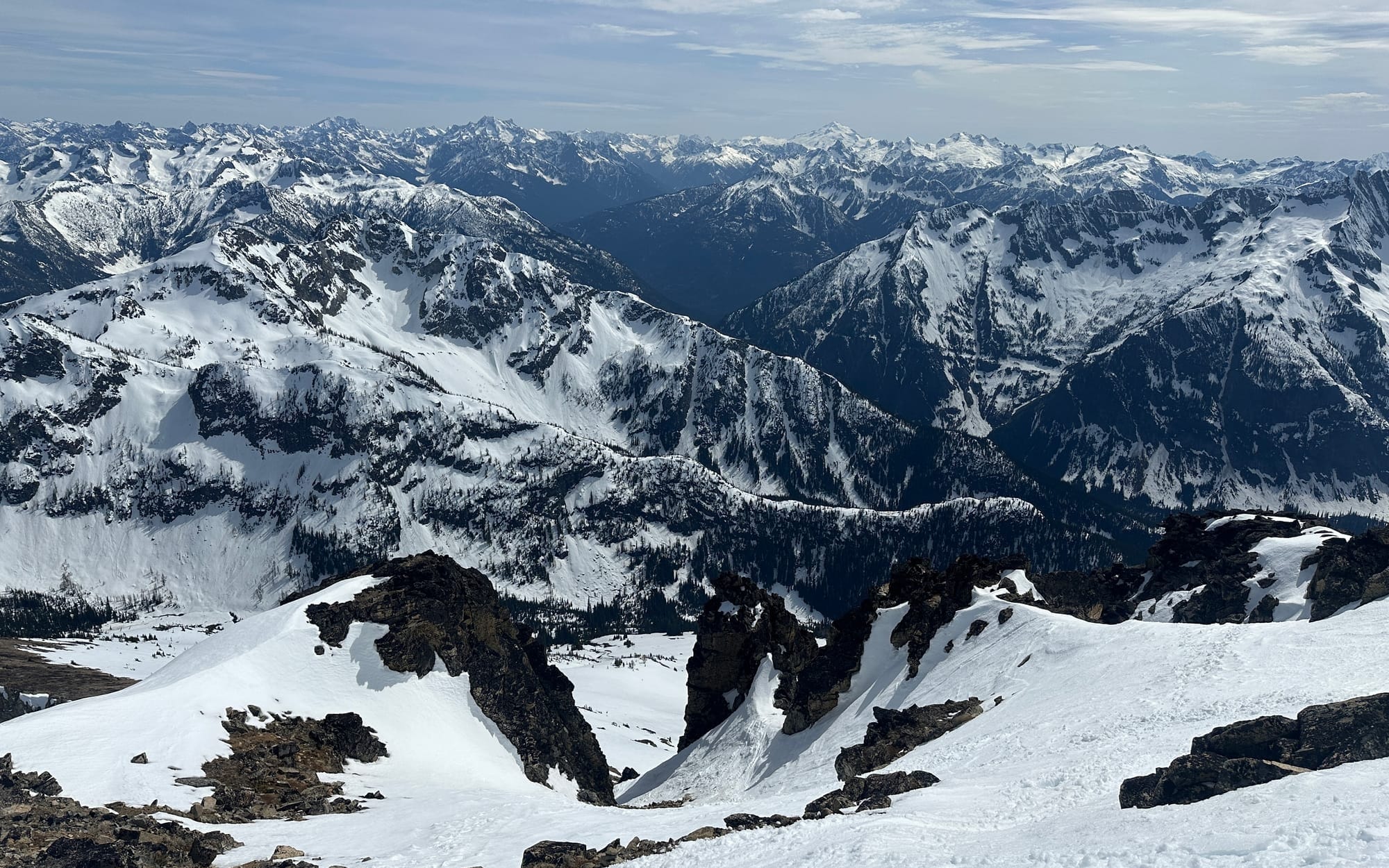
It can be a bit overwhelming at times – the sheer abundance of beautiful and interesting terrain that exists across Washington. Depending on where you look (or who you ask) the cascades here hold somewhere between three and four thousand named peaks. Far more than any one person could hope to even see in their lifetime, let alone climb or ski on. Each of us must decide how we want to filter down this incredible mass of choice. Whether by ease-of-access, word-of-mouth, or pure random chance, we have to find a way of overcoming this absurdity of options.
A quote from Albert Camus comes to me when thinking about this kind of abundance in all aspects of life:
“You will never be able to experience everything. So, please, do poetical justice to your soul and simply experience yourself.”
While I tend to find myself longing more in the way Sylvia Plath does on the same topic, wanting to experience it every little thing, I have tried my best to follow his advice and experience that which comes most naturally. Following my excitement to those things that call me rather than waste away attempting to chase every novel thing or check off every box. And so, the North Cascades had been left aside as a part of this self-selection. They are remote, tucked away out of sight, with limited access and less notoriety. So it was easy to exclude them for the peaks I saw constantly on the skyline. Rather than seeking them out when recommended I instead spent my more limited days in the Baker-Snoqualmie Forest and at the ever shining Rainier, enjoying the bounty of what called out. I felt fine with the self-imposed blinders on as it kept me from choice paralysis. "I'll get out there one day" I told myself, seeing how much I have changed in the past couple of years, figuring it's challenge would call me eventually.
All of this time spent looking at maps led me to the conclusion that one's horizon can only stretch so far, it's inhibited by what we know and what we have seen. Which is why it is so important to have community in these spaces, to be surrounded by others (especially ones who are more experienced and generally cooler than you are) who can bring their own sights and help ours grow.
So, one day recently I received a call from beyond my horizon. A friend was in town, he was joining up with some local skiers he met earlier in the winter, for a weekend in the North Cascades, mainly focused on a ski descent of the South Face of Black Peak (a mountain I had never heard of before this invitation).

After some quick research I was a bit spooked. The mountain was menacing looking, a stark pyramid covered in far more rock and steeper pitches than anything else I had skied in the backcountry this season. It didn't seem out of my abilities, but on top of the size of it, the day would include a party of people I hadn't met before, which always adds a layer of anxiety. How fast will they be? How serious? How stoked? The fear of being the heavy anchor that keeps a team from reaching their objective is strong when I am pushing into the unknown. I planned a few contingencies, places I could wait or stop while the team went higher if I felt uncomfortable, and got myself to a point where I was excited to join.
Day 1: Black Peak South Face
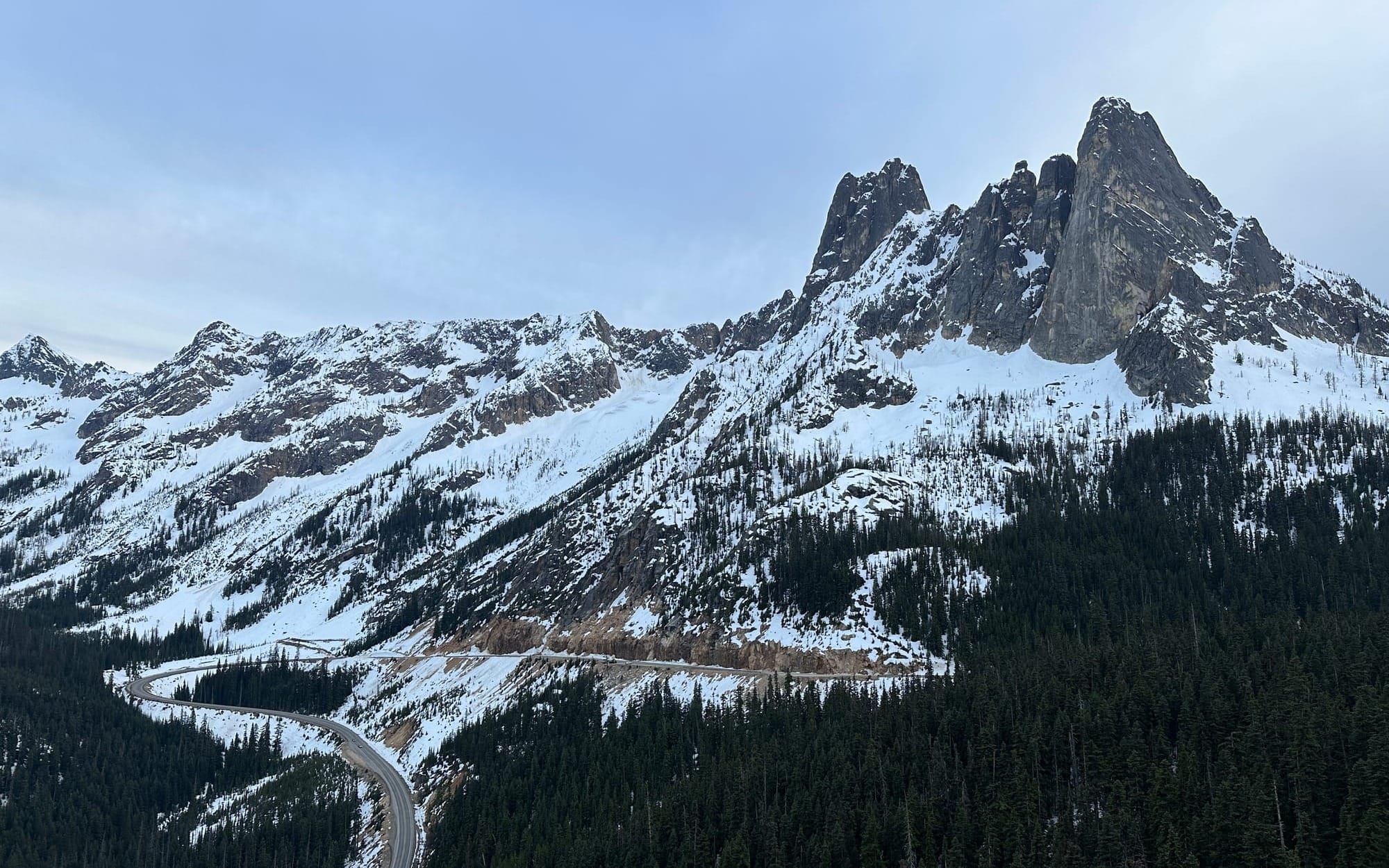
I drove out early, leaving Seattle around 3:30am to arrive before 7am. We were planning as best we could around our expectations of the corn cycle, trying to maximize the quality of the skiing we would receive on the various aspects. The day was looking perfect while I drove up Highway 20, some wispy high clouds, but mostly blue skies. The stoke grew and grew as the mountains did around me.
My buddy was already at the trailhead from camping out the night before, so we met up when I arrived and prepped while we waited for the others. Rainy Pass trailhead wasn't plowed and there was a solid 2ft still accumulated next to the road, a welcome sign after the low tides I had been experiencing elsewhere across the state. Once the whole crew was together and introduced (just a bit later than planned) we started skinning up the summer trail toward Ann Lake.
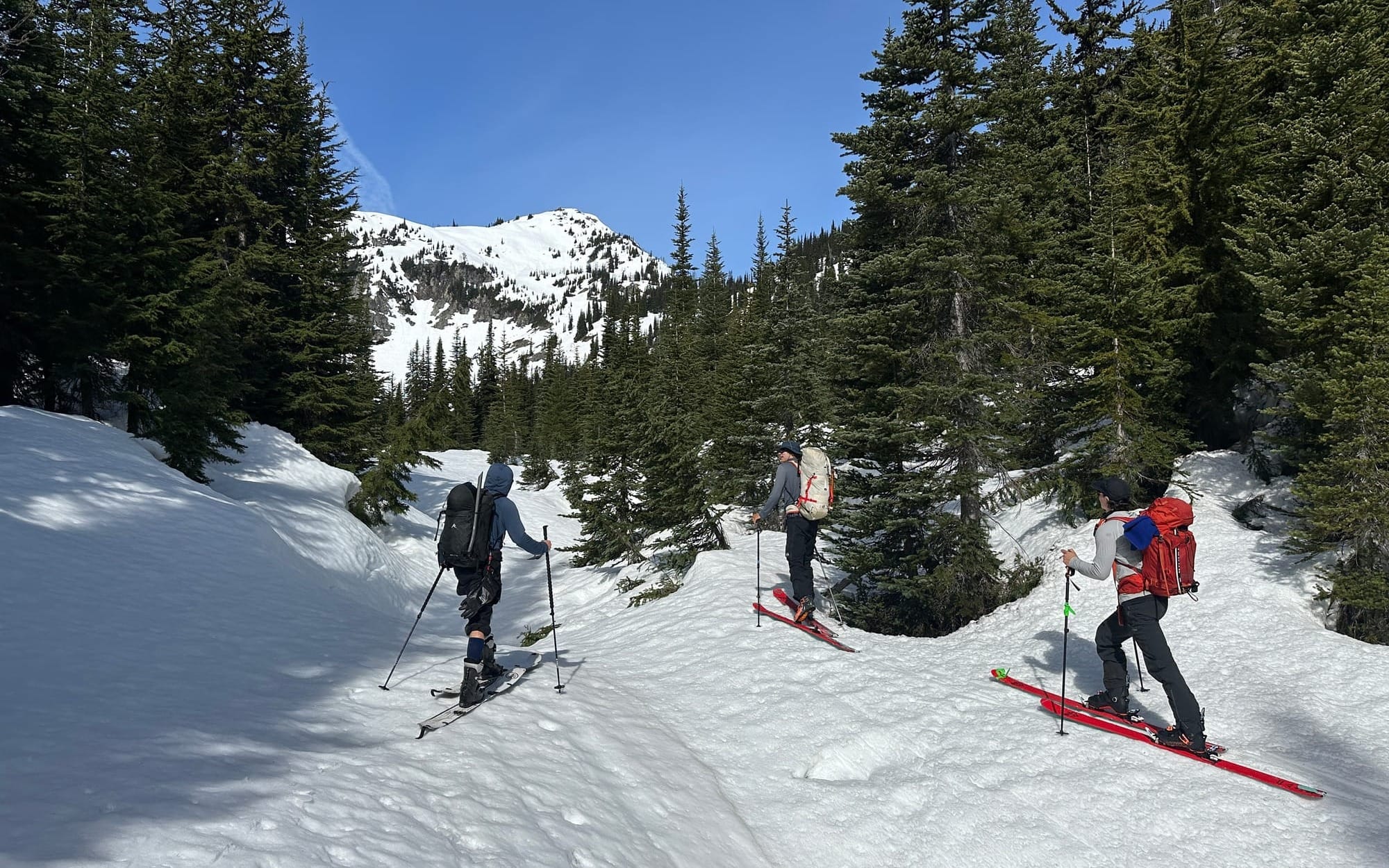
The forest was thick and full of deadfall so once we got past the initial climb (around 5400ft) we dropped down off of the summer trail and skinned the draining to Ann Lake. When we got to the edge of the lake we noticed some pooling forming as the surface ice began to melt around the edge of the lake, but the center looked solid and there were no open spots so we decided to skin across rather than adding time and traversing around the southern edge of the lake. Luckily it was solid and held under us without any issues and we made our way up the other side onto Heather Pass.
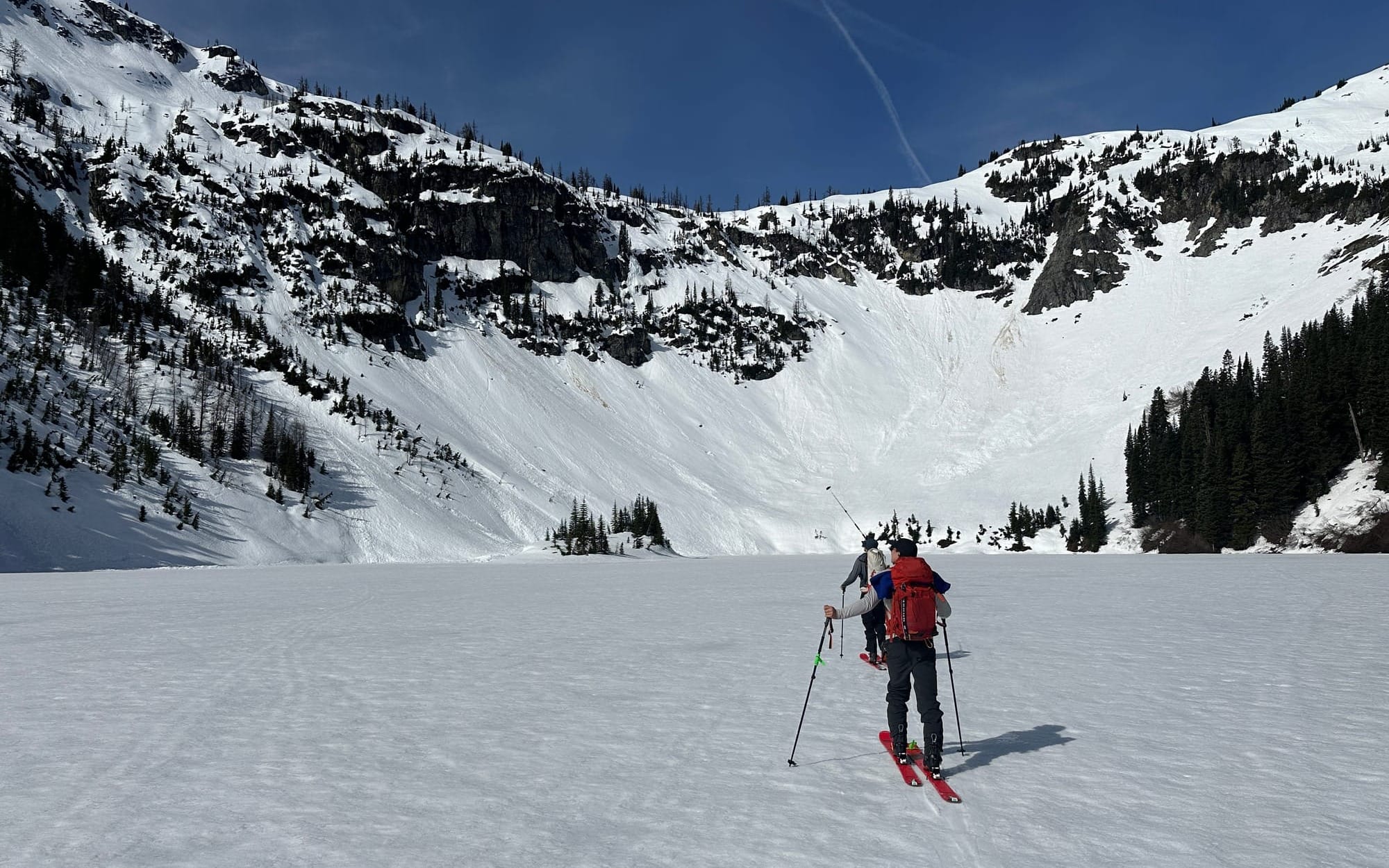
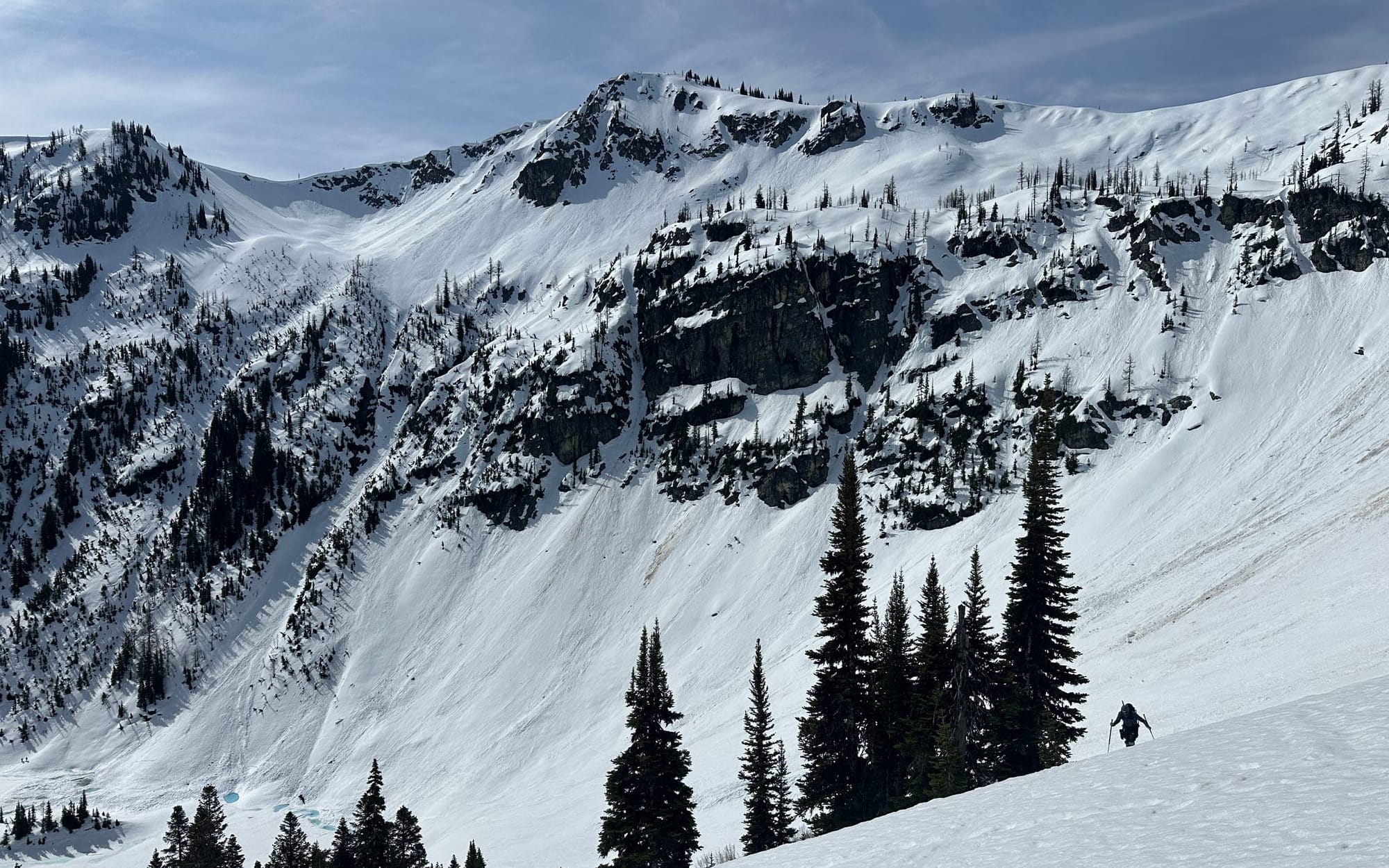
We took a quick water and food break after our first climb and transitioned our skis, beginning the long side-hill to Lewis Lake. It was here that we got our first real glimpse of Black Peaks massive summit pyramid. It was huge and rocky, a perfect picture of a mountain, but still far from us so we ripped skins and traversed towards it. We were able to stay high and contour under the southern ridgeline until around 5600ft, just at the east foot of the lake before we had to transition back to walking.
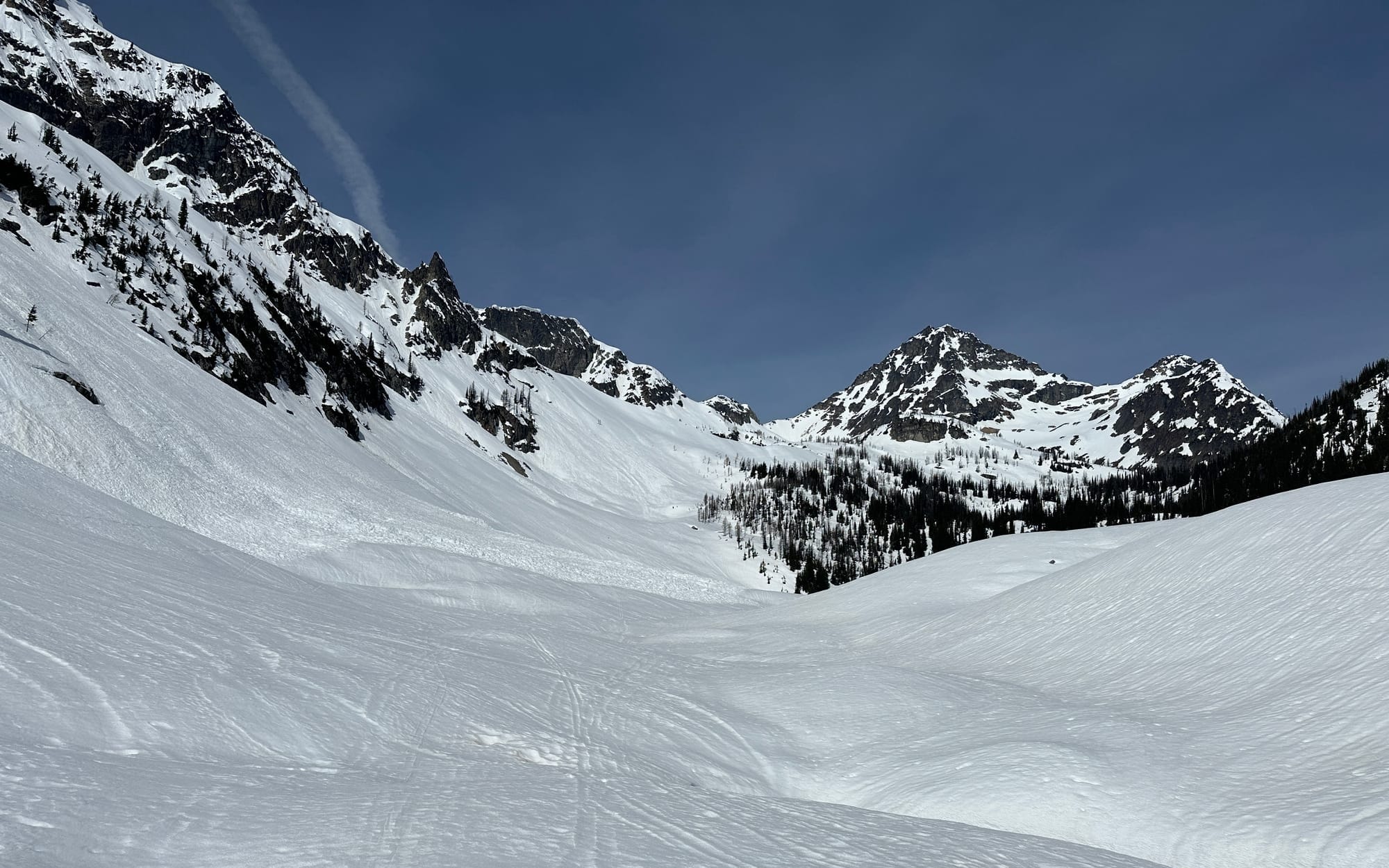
It was a long but uneventful climb, traversing through mostly open and low angle terrain. We watched our left side carefully, while most of the overhead hazards had already run, there were a few remaining cornices that hung menacingly – looking ready to pop as the temps continued to rise.
Since we had started a bit late it was hot, and we were baking in the sun. I was constantly worrying about having botched the conditions for the day. The forecast had called for more cloud cover to roll in and out throughout the day which would have kept conditions cooler, but we were well into the corn cycle by this point in the approach leaving us worried we would be skiing sludge in a few hours when we dropped. The best hope at this point was to catch reverse corn as the temps dropped in the afternoon, maybe even waiting for the sun to droop lower to get it right.
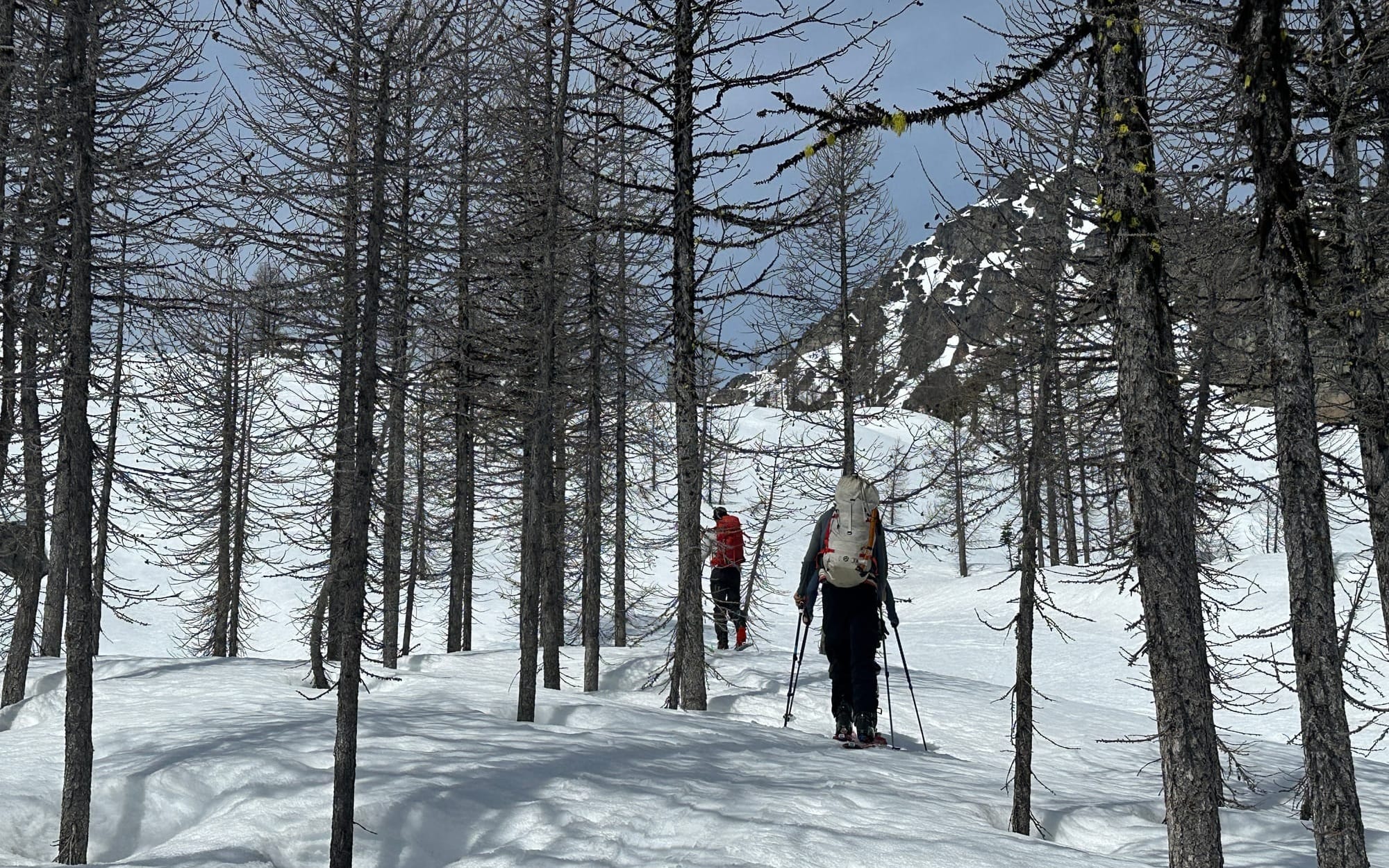
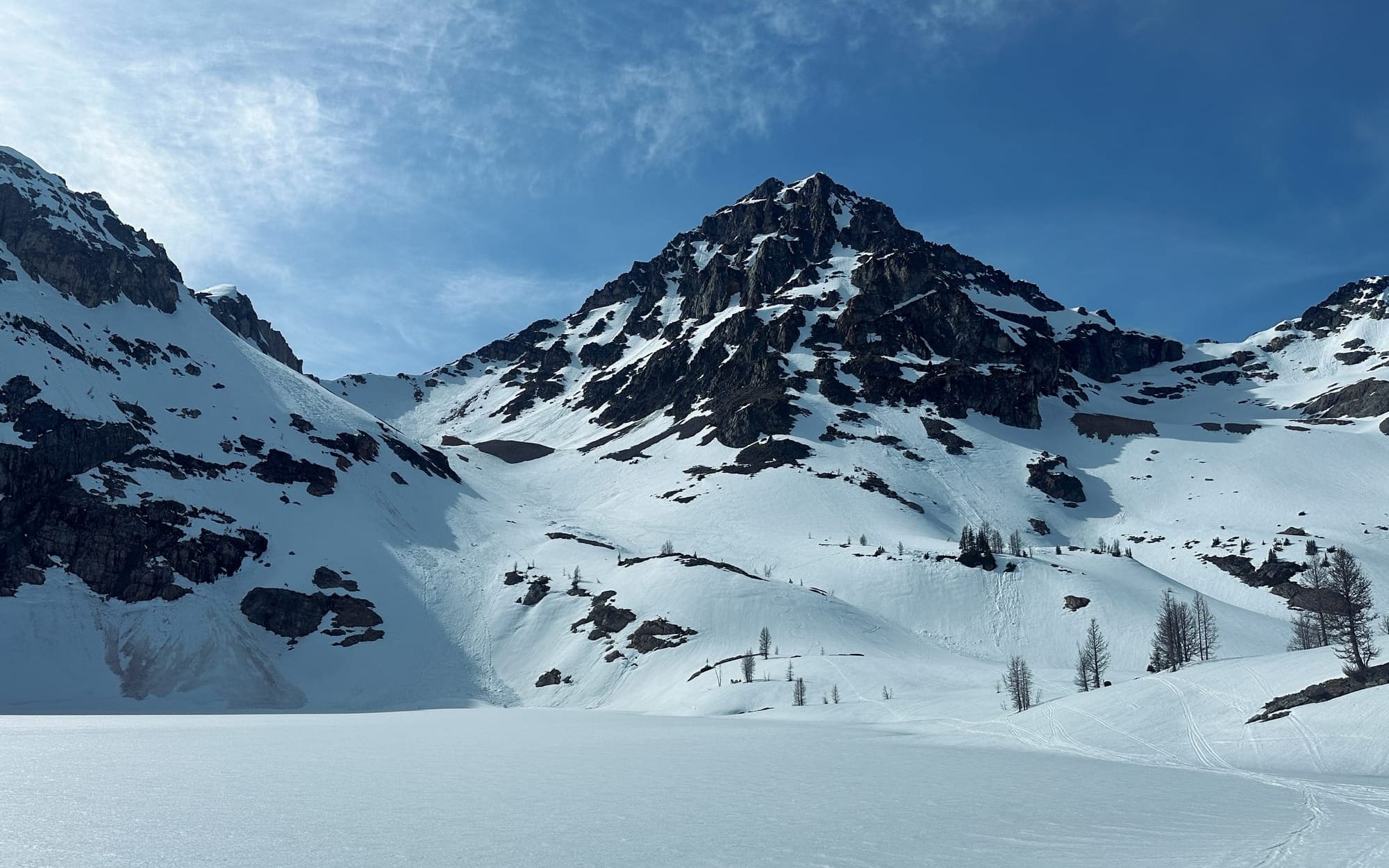
As we passed Wing Lake and headed up towards the ridge the wind picked up dramatically, pouring over the col and into the basin. We relished the drop in temperatures, even adding on layers, as we took off our skis and booted up the col. We chose the lookers left side given conditions, a string of small cornices lined the bowl which would have been hard to surmount and scary to walk under. The boot was short and not too steep, the route we chose required a small section of rock to catch the top of the col, but was fairly straightforward.
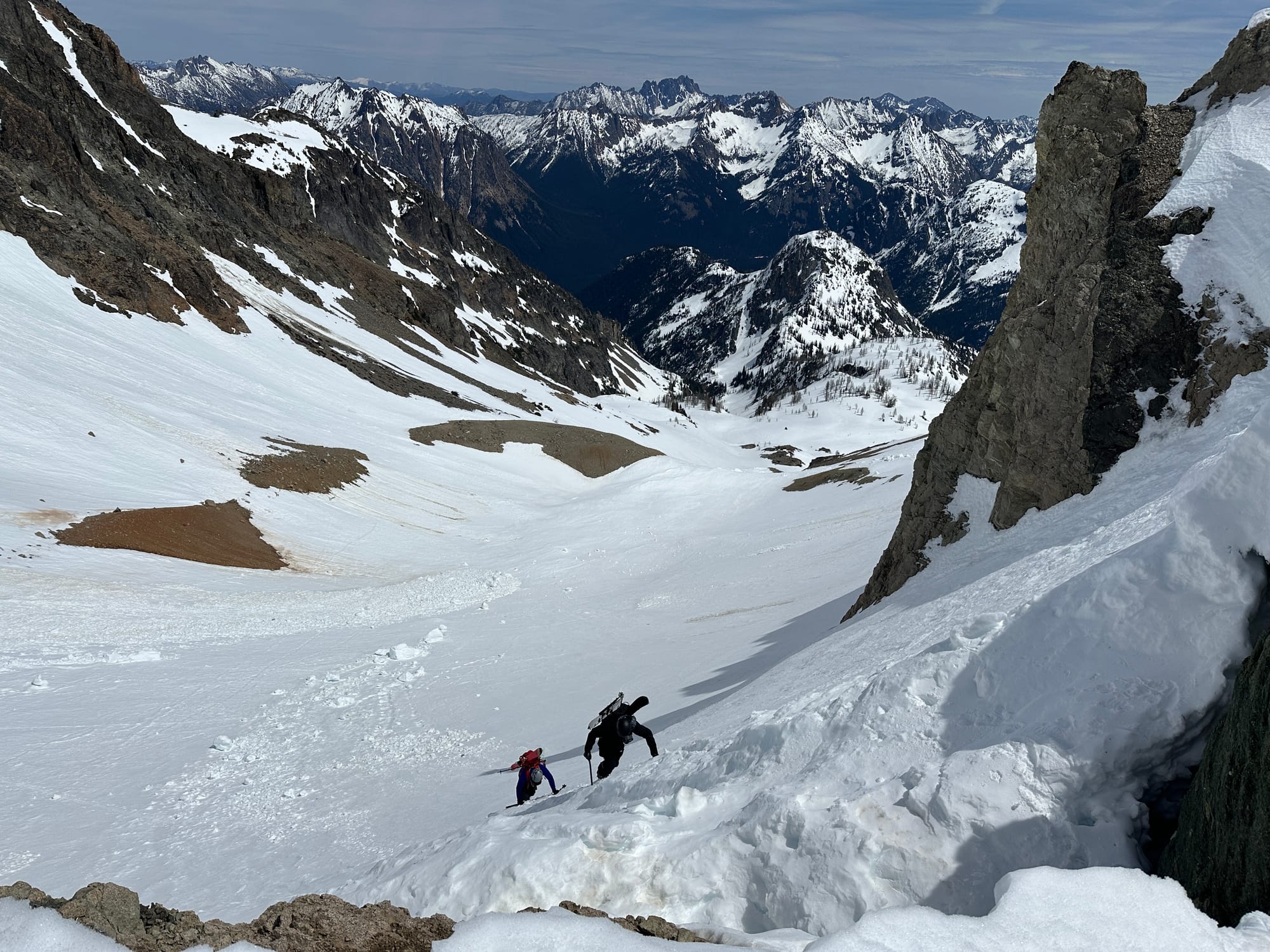
Once on top of the ridge we lost most of our snow cover, instead finding a field of rusty rock exposed between us and the south face. We removed our crampons but kept our skis on our packs to hike over the couple hundred feet of scree. It was at this point that we could finally see our ski line, a thin swath of snow leading onto the large open south side of the mountain. Lower down the coverage was spotty, and our original plan of navigating back through Last Chance Pass took a final hit. We decided then that we would come back over this pass and return the way we came after skiing the technical upper portion of the line rather than risk the conditions somewhere we hadn't seen yet far further below us.
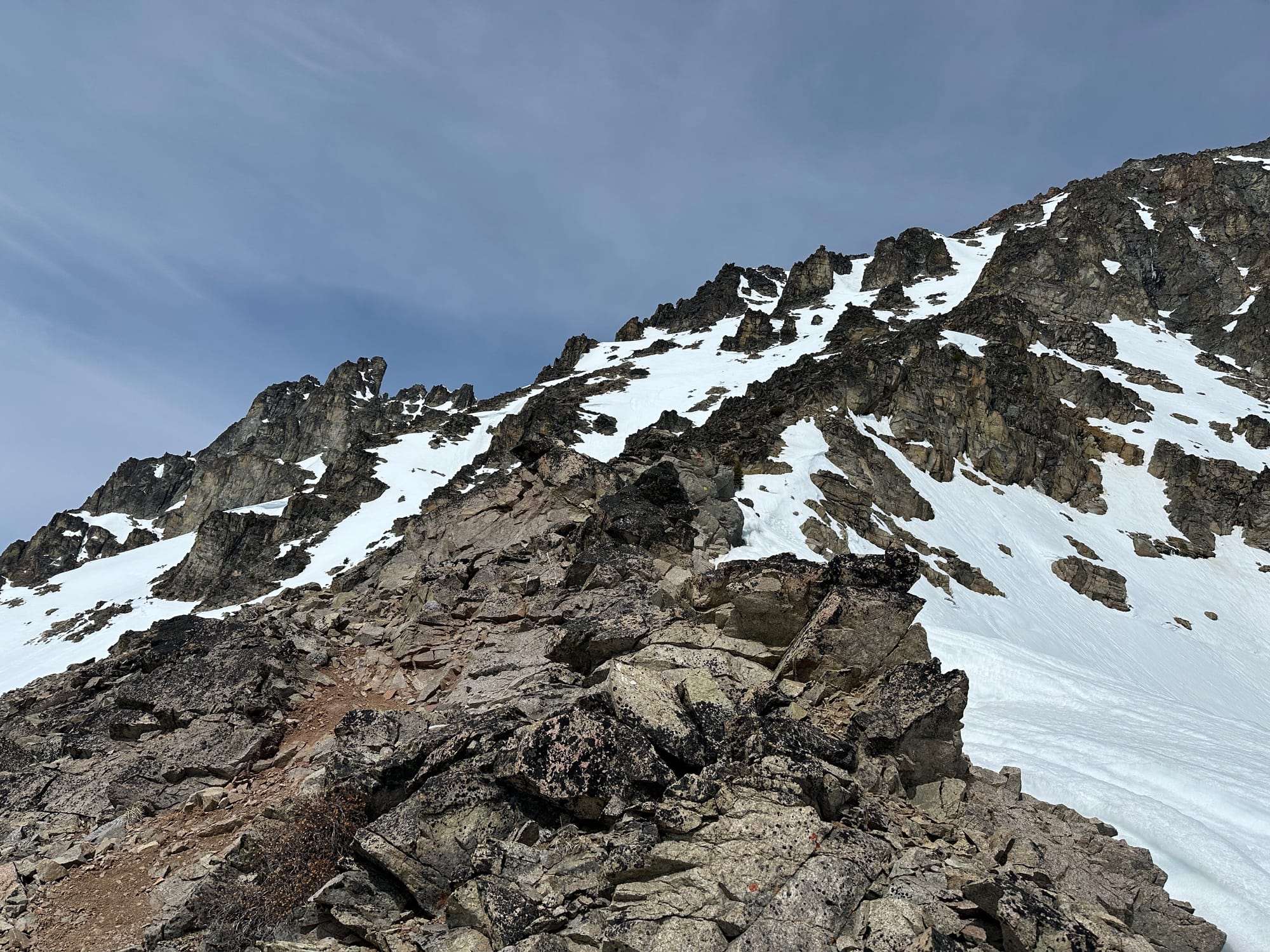
After stumbling through the loose rock we donned our crampons again and began booting up the final 1000ft or so of snow before the top of the line. The snow was warm and the exposed rocks heated it even further making much of the snow rotten below our feet. We tried to stay in the center where the snow was coldest, but post-holed a good percentage of our steps anytime we had to pass by exposed rocks. At one point we passed a rock formation that chocked the line into a narrow corridor, and a group mate sunk waist deep into the bergshrund-like opening that had formed underneath it where the snow had melted out significantly.
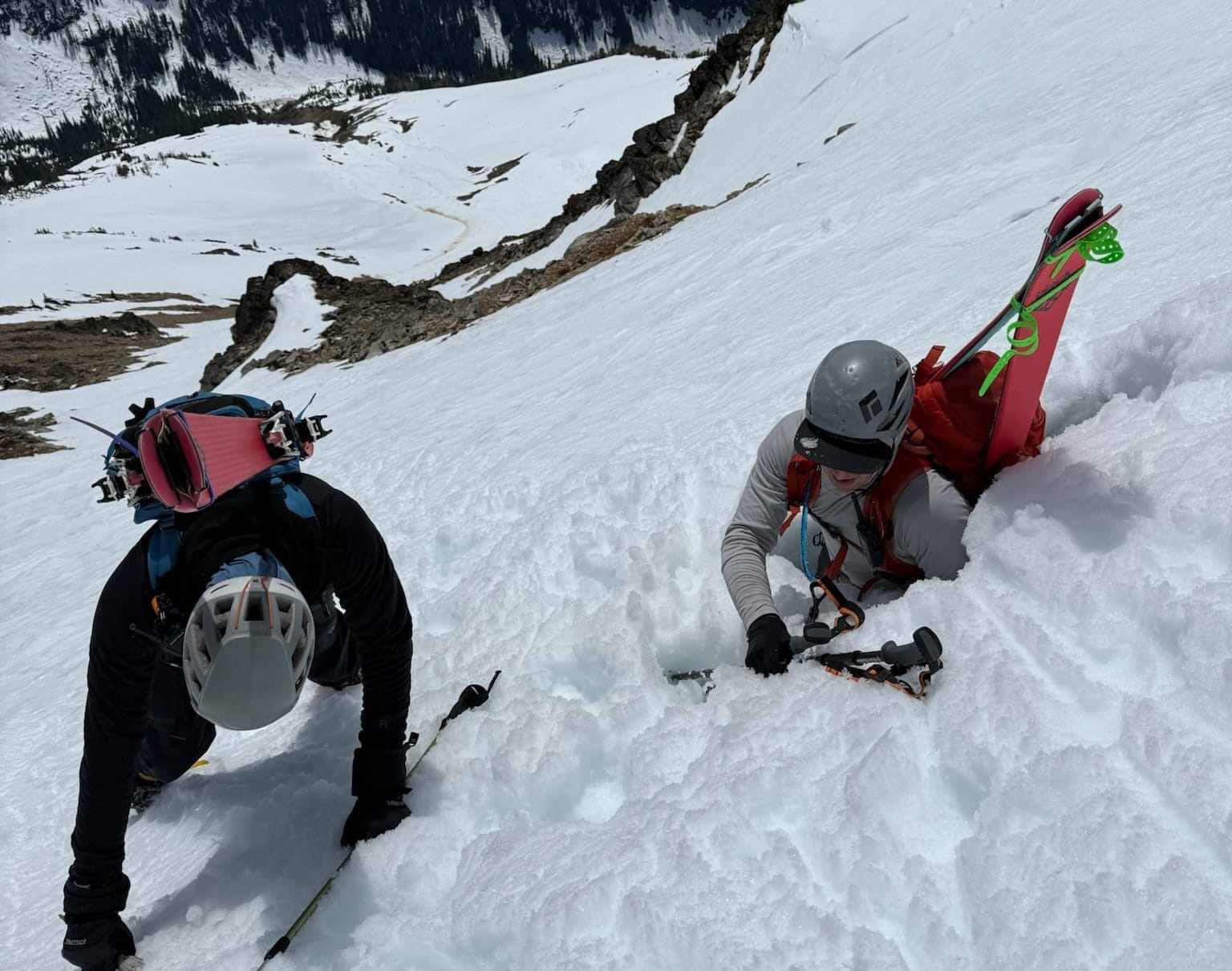
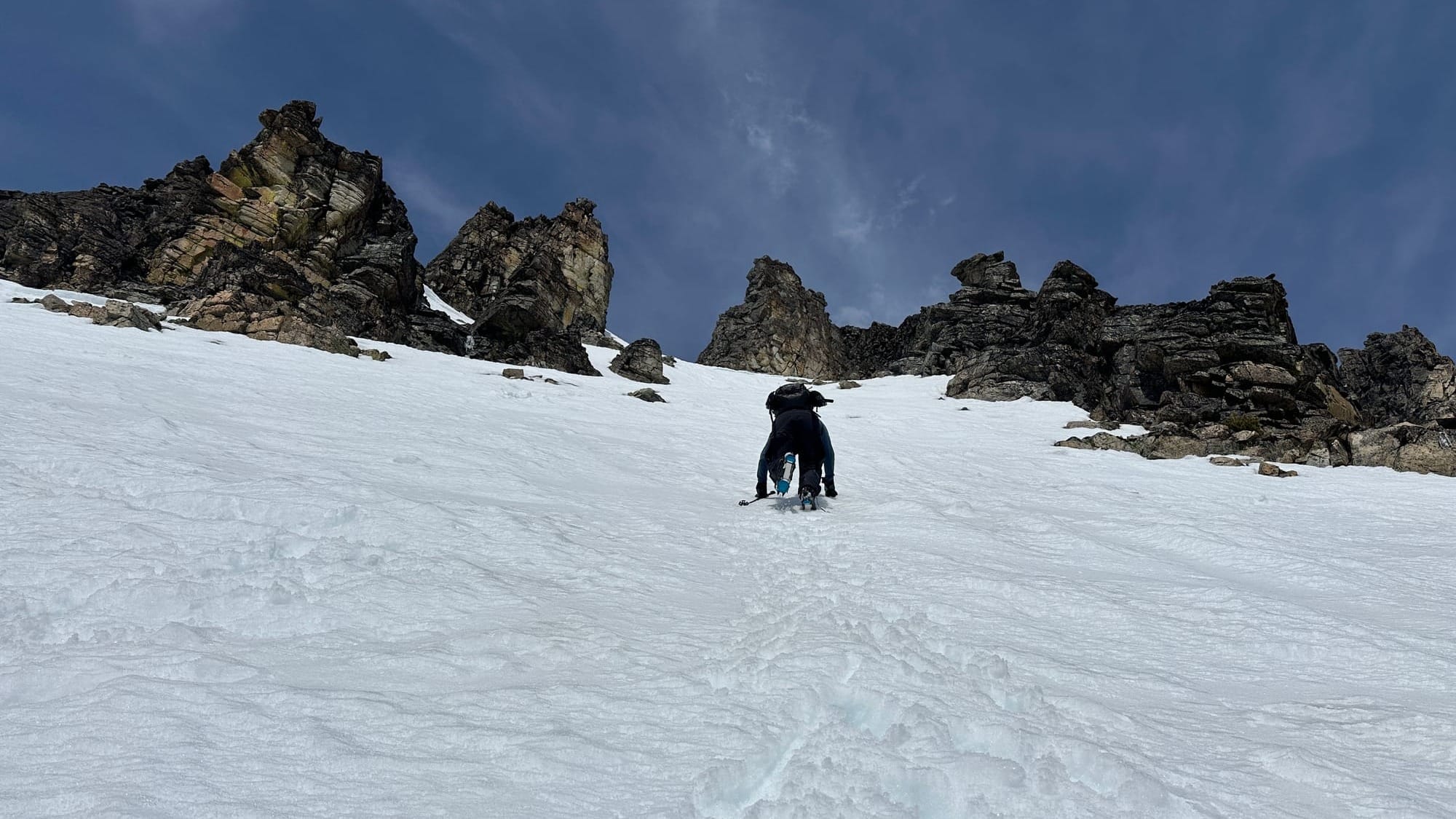
Once we made it through the long slog up the snow to the top of the line it became nothing but rocks. Thomas and Hayden clambered up them, doing the short scramble to the true peak of Black. I decided instead to rest and eat while enjoying the massive view of the North Cascades. Both post-holing and the heat had beaten some of the excitement out of me and I wasn't up for rock climbing in my ski boots, I needed to save the energy I had left to ski.
From the top you could see Glacier Peak, Goode Mountain, and hundreds of others I couldn't name by sight. It was miraculous. Enough to make me wonder how I had kept myself out of this place for so long. The peaks felt huge (even bigger than the mountains I was now starting to get used to in the more-southern-cascades) and absolutely endless.
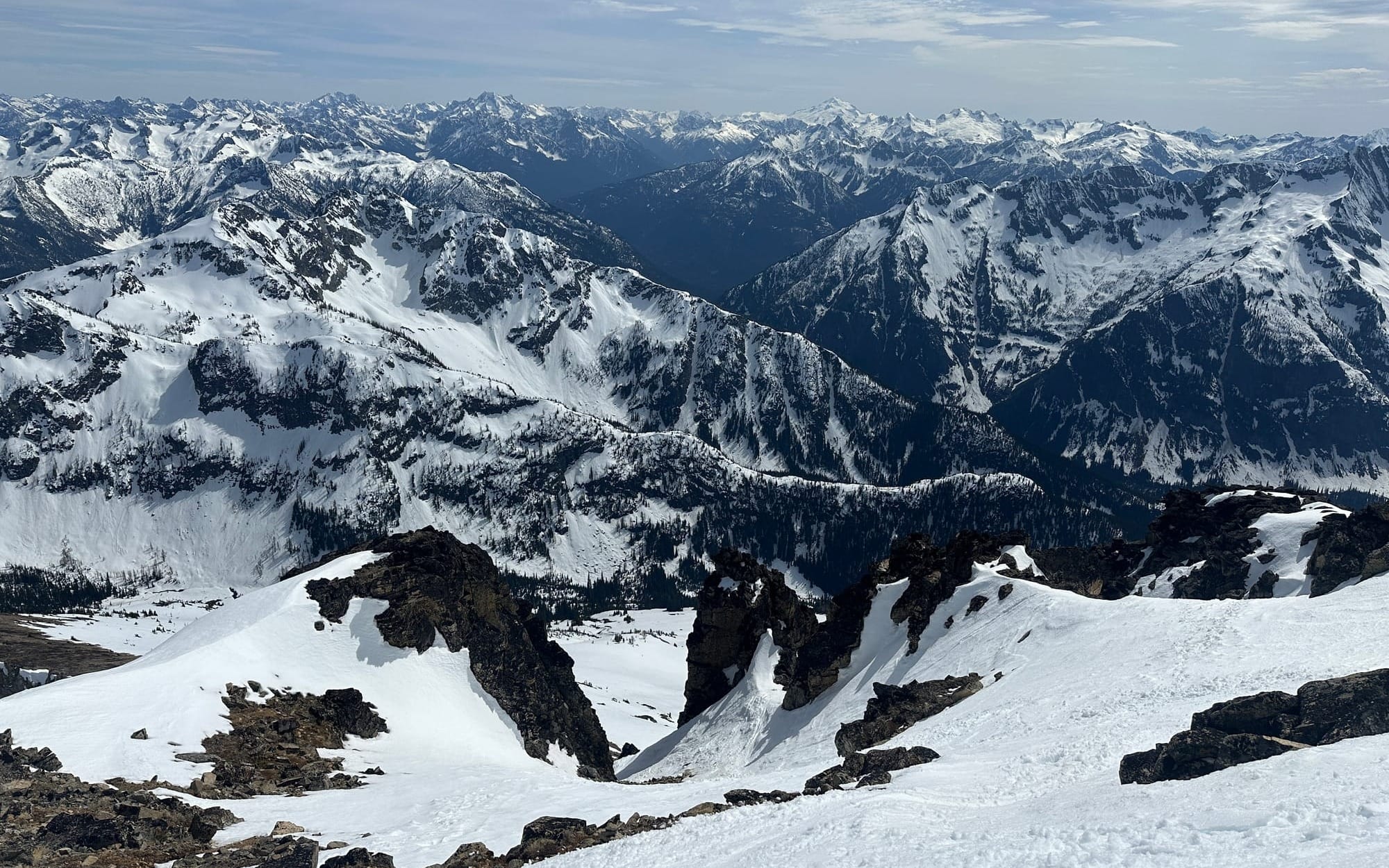
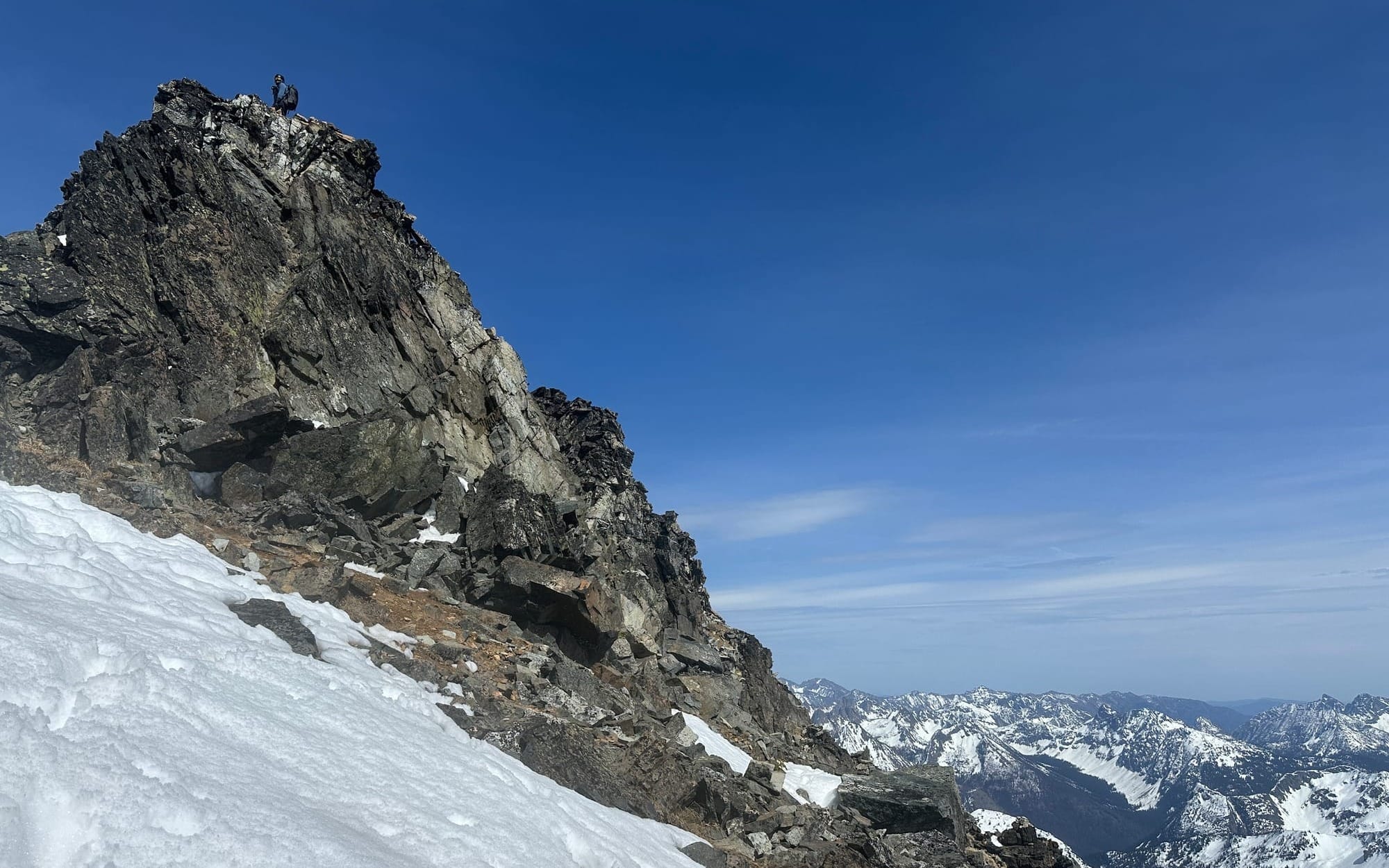
Once the group had their fill of scrambling we transitioned our skis and started excitedly down the steep line. Despite the snow being in poor condition for climbing, it was in pretty great condition for skiing. The slush made for well controlled turns despite the pitch of the run, letting us open up and ski strongly despite tired legs. We took it one-by-one and skied a few hundred feet lower than where we started booting, where we transitioned back onto the rock to regain the col so we could drop back into the basin leading us to Wing Lake.
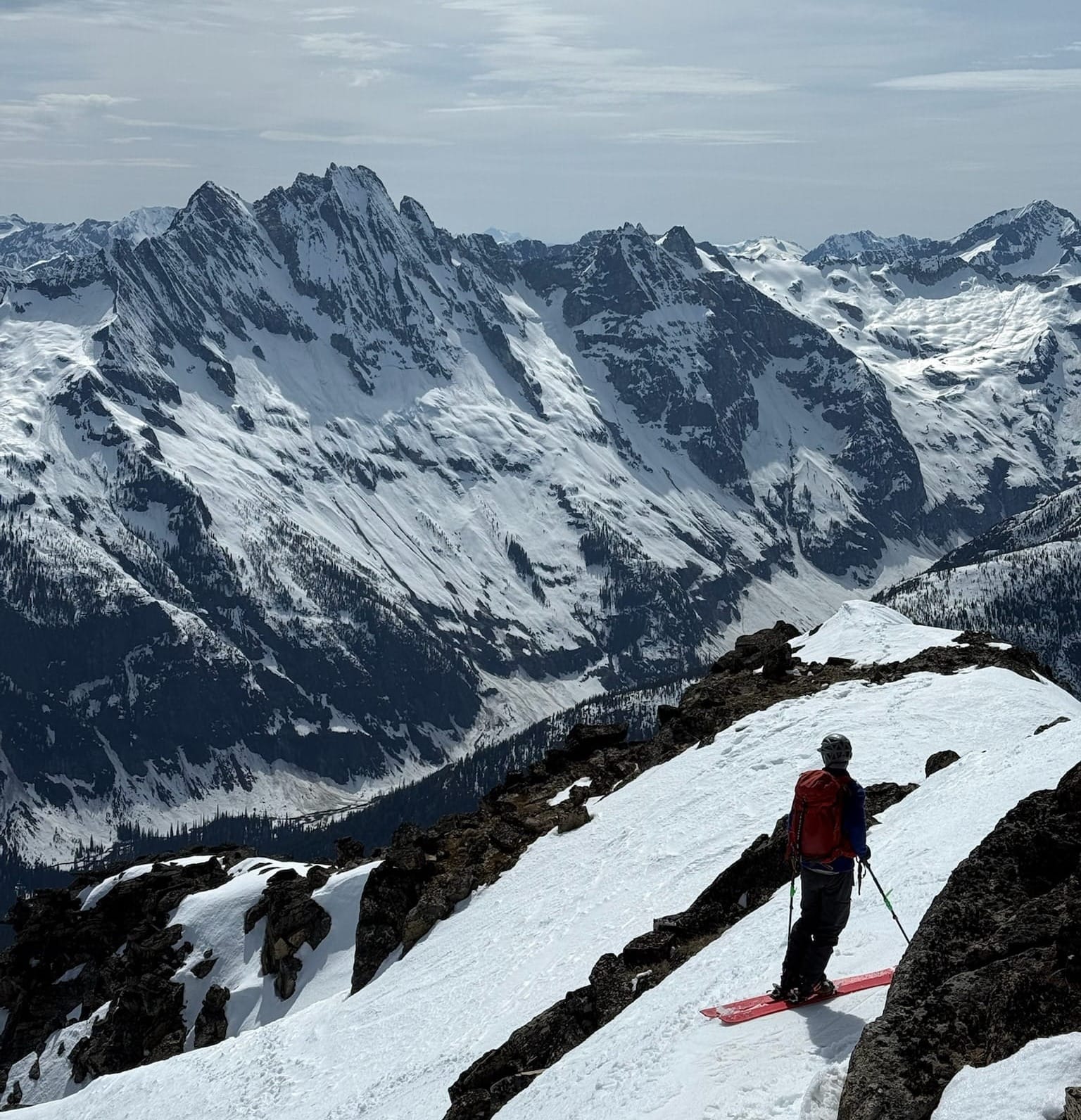
We took the skiers left side into the bowl, the more traditional approach route, rather than trying to ski over the exposed rocks on the skiers right where we had climbed. There was a short steep entry to avoid airing out the small cornices hanging over rock, but the skiing from here was even better than above. The wind in the basin kept the snow colder and we were able to ride fast, at some points getting proper reverse corn. We pointed our skis down where we could and contoured where we couldn't to avoid transitioning again until we made it back past Lewis Lake to the climb back up Heather Pass.
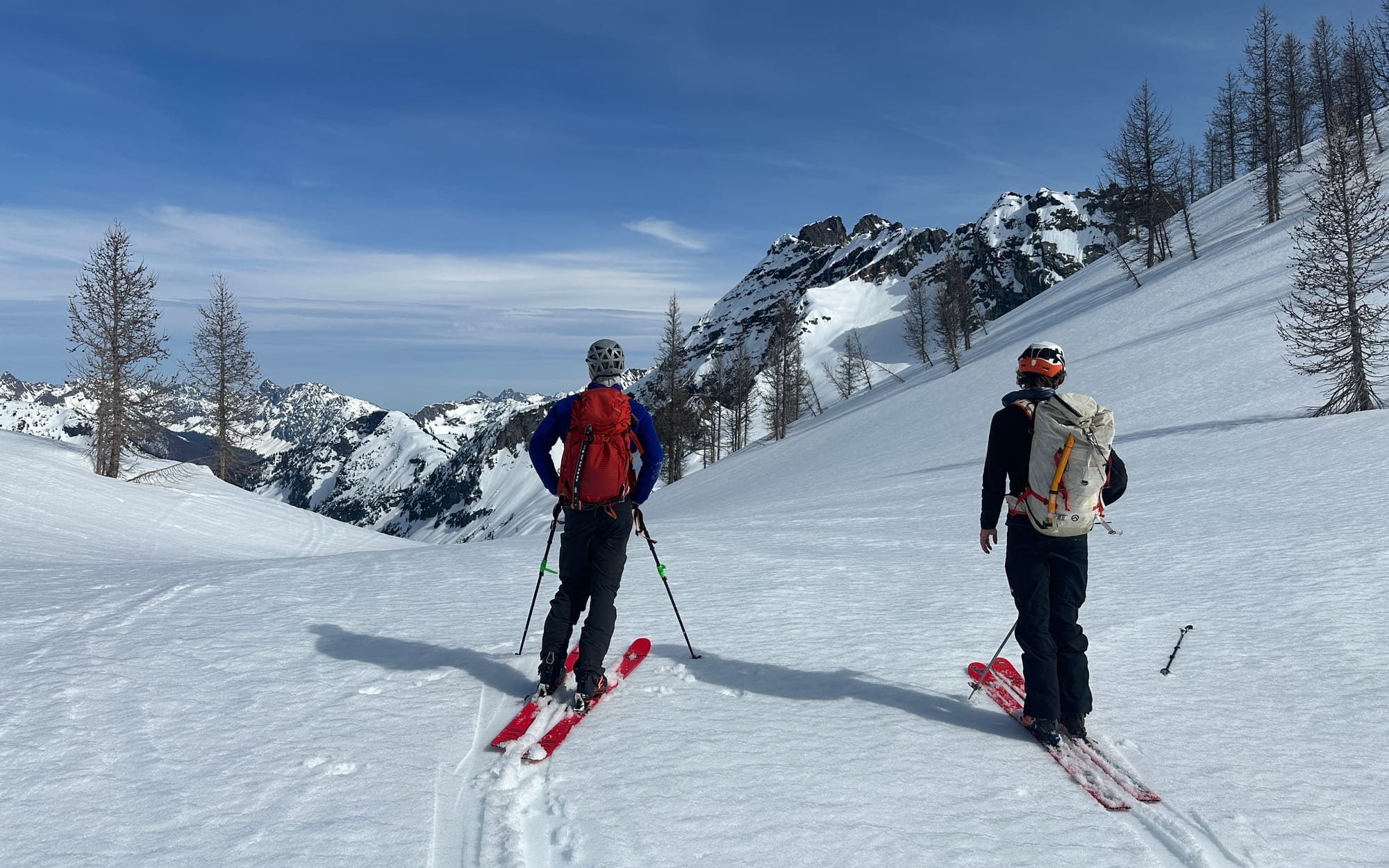
It was a straightforward, side-hilling skin up the pass, and we made quick work of it. I was eager to make it back to the cars where more water and food awaited and I could remove my sweaty boots.
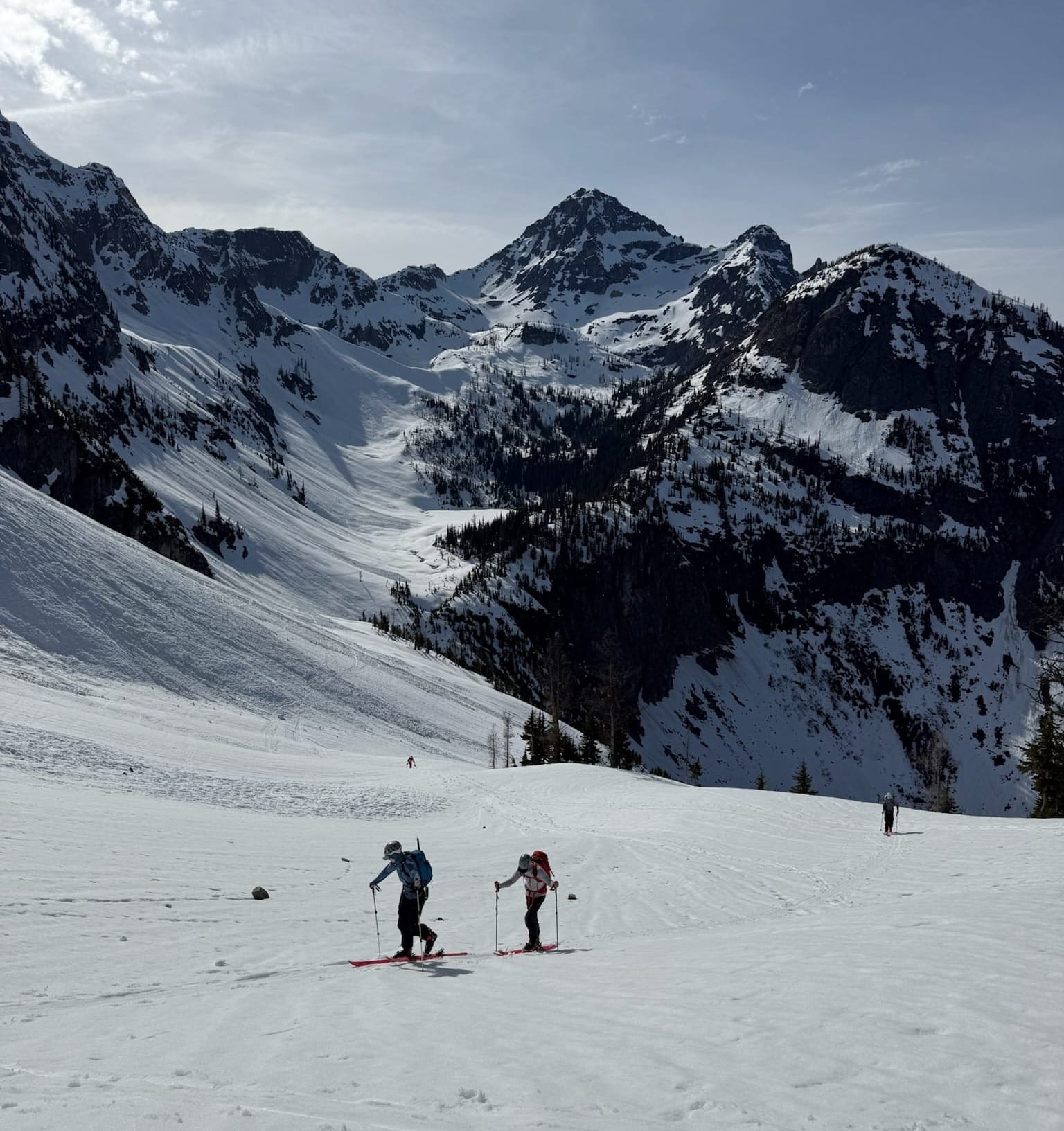
Once we reached the top of Heather Pass, and started the ski descent back to the car, we could see Ann Lake was now significantly more melted out than it had been when we crossed this morning. The entire surface was puddled and the edges had opened up, firmly marking the lake off as a possibility for descending on. We cut through the trees, trying to stay on what little snow remained (sometimes having to ski over patches of dirt and bushes) to make our way along the summer trail. The group split up a bit at this point, depending on our skill an maneuvering through trees and walking up and down sections on skis (Evan our split-boarder was having a terrible time). I transitioned back to skins once to walk the flattest section in the Ann Lake drainage, before ripping the skins at 5400ft and making it back to the car with a little bit of pole pushing.
The day had been a success. The ending GPX line showed us at traveling 10.8mi and 5200ft of gain, though the watches in the group had those numbers higher – around 11.5 miles and 6000 ft. Either way we were out on the snow for a little over 10 hours with plenty of stoke built up!
We camped out at Blue Lakes Trailhead that evening, making steaks and fries on Evan's van stove, building back up our energy for another day of skiing tomorrow. We had visited the overlook and (without a real plan for the next day) scoped out new lines, landing on the Big Kangaroo. The couloir still looked filled in as far as we could tell, and you could access it almost directly from the road which was a nice change after such a long day. It was a wickedly aesthetic line - climbing straight up for nearly 3000ft, tightly wrapped in jagged red-orange rock - I had been hoping to avoid more booting (given the day we had just gone through), but it was hard to deny the appeal.
Day 2: Big Kangaroo
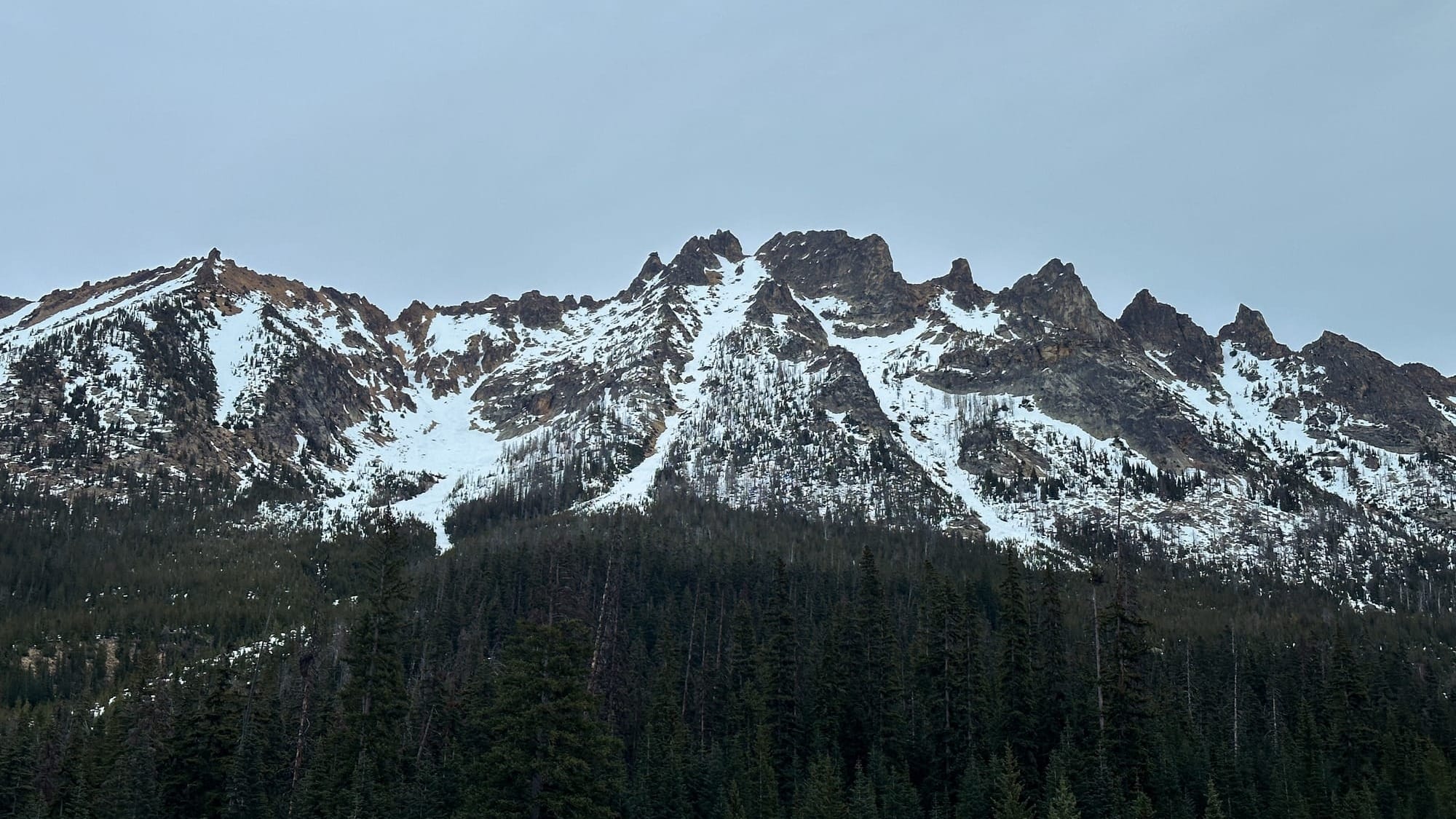
We got a nice casual start to the day – waking up as dozens of people were pulling into the Blue Lakes parking lot to begin the notorious Saturday migration up the Birthday Tour. After warming my boots and bones in the car we headed to the hairpin to find our way up. We had no real plan. Sure there was a forest between us and the couloir, but it was so close! How hard could it be to find our way to the base of it?
After a short creek crossing and two hours of bushwhacking, mud-walking, and post-holing, we escaped the dense forest and made it onto the open slopes of the lookers-right couloir.
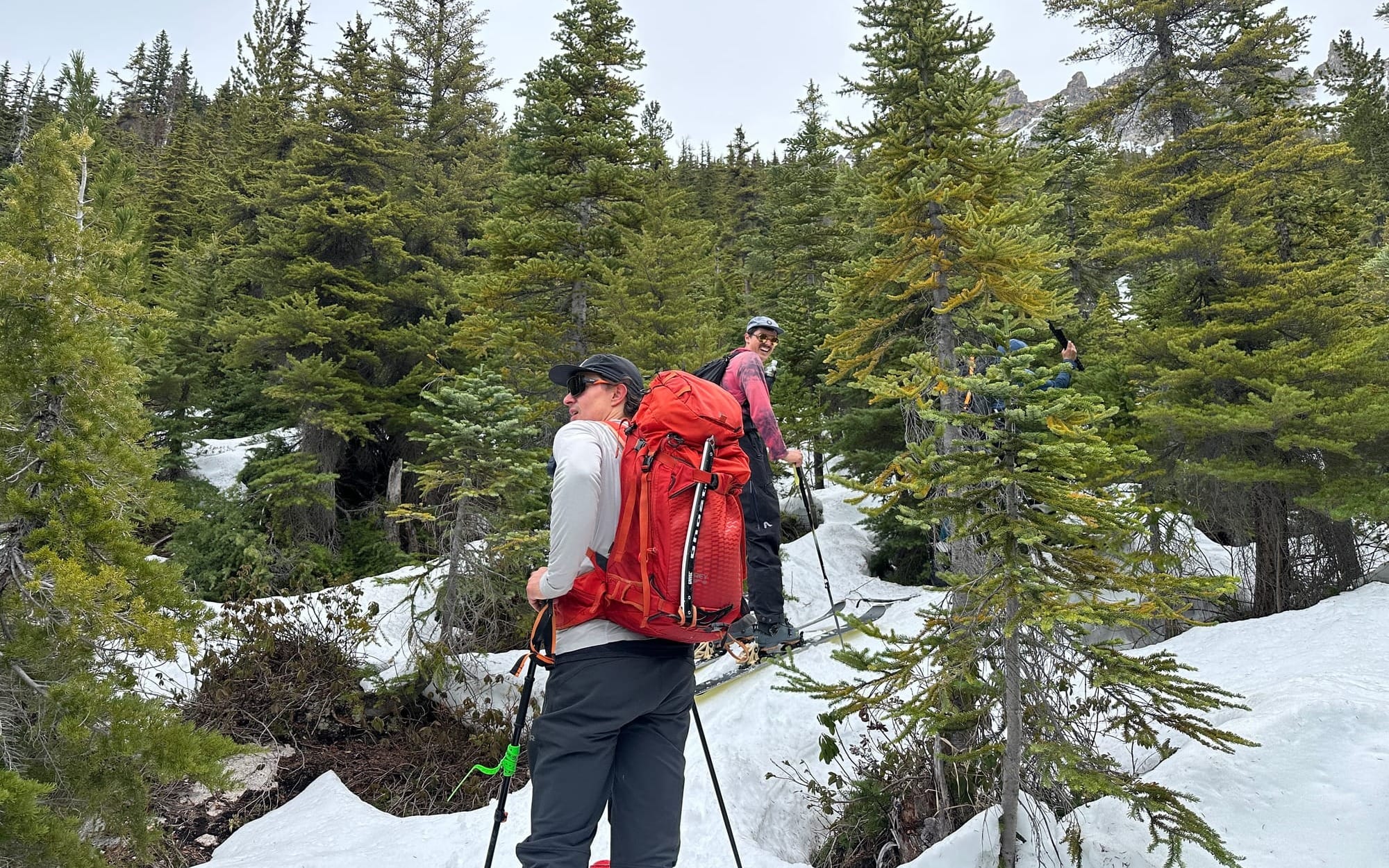
I hesitate to go into more detail than that as our directions were hopelessly wrong and put us through some of the tightest and steepest tree approaching I have ever done (and we didn't even make it to the right place!)
We started up the lookers-right couloir, feeling fairly confident that it would connect to the line we had actually intended to ski further up, but if it didn't we would be skiing down this line. The drainage was filled with avalanche debris, rocks, and crunchy snow. Not ideal conditions for skiing. I crossed my fingers, praying to the mountains to not have to ski here... and that the conditions would be better on the other side.
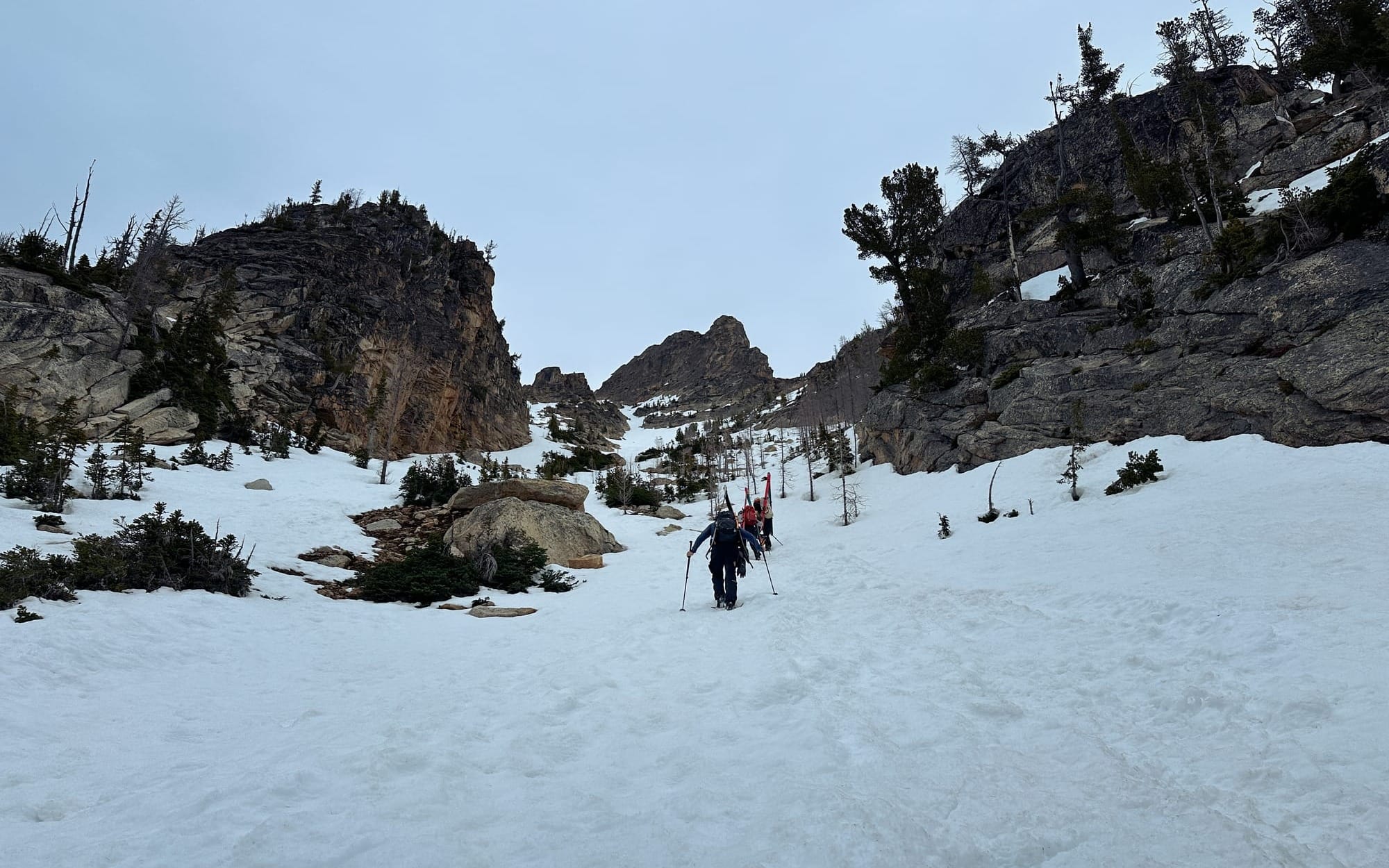
We made quick work of the slope, the hard snow and directness of the couloir made for speedy booting. Slowly the terrain steepened and we found the bridge between the couloirs around 7200 ft, a wide field of snow for us to cross. The conditions didn't improve much as we crossed over, but there was far less avalanche debris and rocks here making the line look much more enticing.
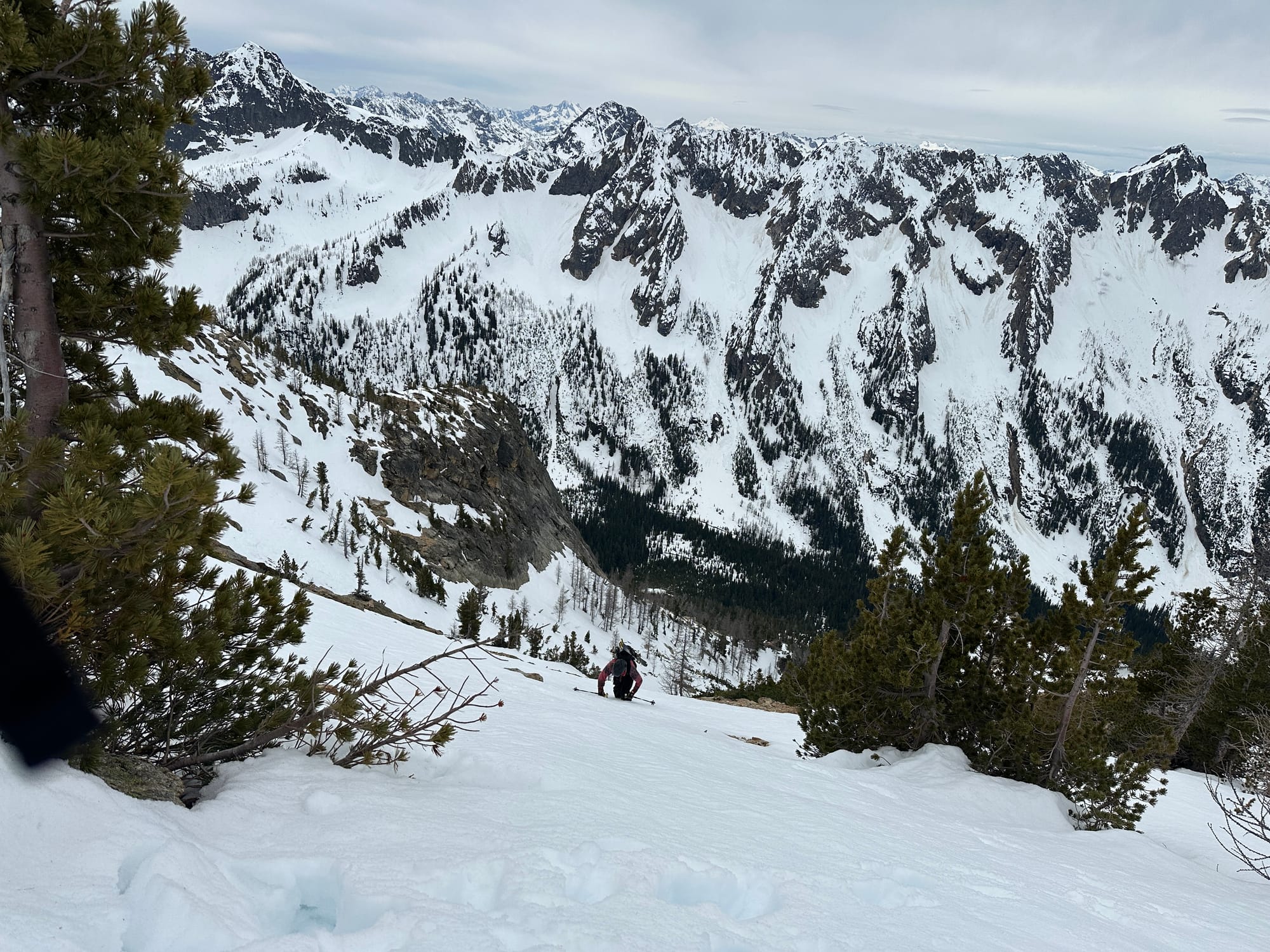
Thomas and Evan who had been leading the pack the whole day were about 500ft ahead of the rest of the group, and as they reached the top of the col the rest of us decided to stop at a rocky outcropping around 7700ft so we could all transition at the same time (rather than making them wait for us to get to the top). By this point my legs were giving out, after tripling the amount of booting I had done all season in a short two days, I was eager to give them a break.
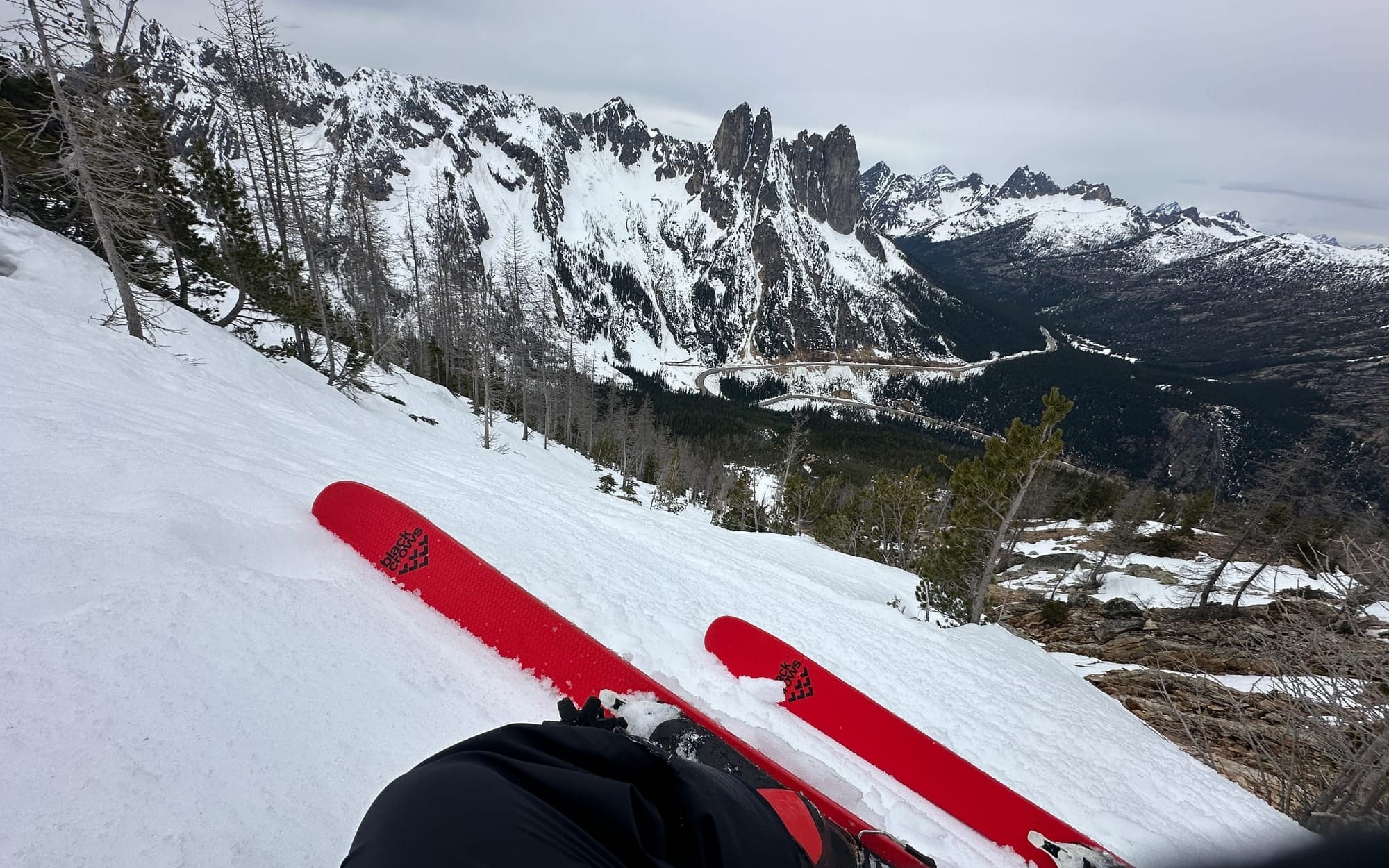
Unfortunately for us the clouds stayed socked in the entire day and the snow was rock hard as we took our first turns. I skidded dramatically with each turn as my exhausted legs struggled to maintain decent control. Watching the two drop in from the top, where the conditions were even worse, I quickly lost any regrets I was holding onto about not making it to the col. After a few hundred feet it slowly began to soften, eventually turning to a softer top layer that we could edge our skis into and link turns. Despite the bulletproof upper portion we managed a decent 1000ft of good skiing before re-entering the tight trees that would be our descent.
There was another party transitioning from skins to booting at the bottom of the couloir and they gave us good intel that they were able to keep their skis on all the way up to this point. If we just followed their tracks we would be able to ski all the way down to the road! I highly recommend this path both up and down if you are ever out here attempting this line.
We navigated down through the forest, making tight quick turns, only hitting a few rocks and tree roots, but ending up much more successful than the approach line. The group had been right we were able to keep our skis on almost the entire time (we popped them off to traverse a section, but a more motivated skier could have done it without) and made it down to the creek beside the road with little issue. However, one of the primary reasons we had gone further east on the approach was to utilize a snow bridge across the creek. Closer to the road there weren't any obvious crossings, but we were tired and rather than trek a couple hundred feet east we popped our skis and attempted to rock-hop across. One bad move and I ended up with ski-boot fully submerged. Luckily it happened at the end of the tour so I could quickly hobble to the car and dump the water from my boot rather than have to suffer with trench foot all day.
Despite all of the shenanigans, we made it through the day and skied a line just by sight! I ended with just under 3000ft of gain in 3.2 miles (a steep day) and a thorough respect for any well defined skin track through trees.
With the North Cascades fully opened to my horizon I know I'll be back soon. Maybe not for anymore skiing, but the summer is around the corner and there is plenty to do on foot. So take my experience as a reminder: there's always more to see just beyond what you know, let the people you have surrounded yourself with guide you to new and interesting places even if they feel out of reach.
